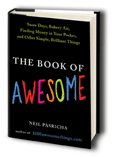How to Tell Which Printing a Book is From
September 24, 2010 at 2:00 am Broken Secrets 3 comments
By Chad Upton | Editor
Books were once a luxury.
That changed with the printing press, making duplication of books faster and cheaper, which made books more accessible to common people. Eventually, public libraries made books available to everyone in a community.
 The way we access books is changing again, by eReaders like the Kindle and iPad.
The way we access books is changing again, by eReaders like the Kindle and iPad.
If you browse the Kindle forums on Amazon.com, you may notice that eBook snobs refer to normal books as DTBs (Dead Tree Books). While eBooks are a status symbol now, they may eventually be the way common people access books, making paper books a luxury once again, reserved for expensive hardcovers and collector editions.
For some people, the only books they have ever read were the ones they had to read in school. This year, many high schools and colleges are using iPads and Kindles to distribute reading materials. It’s not because they’re fancy, it’s actually quite practical.
Although the initial cost of the device is high, the cost to create and distribute electronic books is almost negligible. The cost of a Kindle ($139) is about the price of two or three large college textbooks. At that rate, the device could pay for itself in the first semester.
Because it is much cheaper, faster and easier to download books, eBooks may eventually replace paper books as the primary way we read. Like I said, the reading devices are expensive, but even if people don’t want to buy a dedicated device, chances are good they already own one that is compatible. Amazon has already made software that allows Kindle books to be downloaded and read on Windows and Mac computers, iPads and iPods, along with all of the major smartphone platforms (iPhone, Blackberry and Android).
The future of books may be eBooks. In the meantime, it’s hard to know how popular paper books are, unless you know this secret.
 When a book is printed for the first time, the publisher doesn’t know how well it will sell. They print a limited number of books to minimize the risk of their investment. If the book sells well, they can always print more.
When a book is printed for the first time, the publisher doesn’t know how well it will sell. They print a limited number of books to minimize the risk of their investment. If the book sells well, they can always print more.
Most publishers list the number of the printing in an ambiguous format on the publishers copyright page near the front of the book. They put the numbers 1 through 10 on their own line near the bottom of the copyright page. Sometimes, they’re in left to right order from 1 to 10. Other times, the numbers alternate from left side to right side, with 10 in the center.
The lowest number you can see on this line is the printing that the book is from. When a book goes into its second printing, the number 1 is removed. On the third printing, the number 2 is removed and so on.

1st Printing

9th Printing

12th Printing
You can see that the numbers alternate from left to right. They sometimes do that so the remaining numbers stay centered without adjusting the printing of the remaining numbers. If you see them in a book and they are not alternated, the remaining numbers will be off to one side instead of being centered (they don’t normally adjust the type to re-center it).
Sometimes, printings are confused with editions. A book may go through many printings and still be considering the “First Edition.” Generally, the edition doesn’t change unless the content in the book or the publisher changes.
The images above are from one of my favorite books, The Book of Awesome. As you can see, this book has been extremely successful — it’s in its 12th printing! Frankly, it is an awesome book and I’m not just saying that because I’m trying to be funny or because I’m in the book — the sales speak for themselves, it is a great book.
Broken Secrets
Subscribe on: Facebook | Twitter | Kindle
Sources: Travelin Librarian, Between the Covers, Wikipedia (Books), Kotaku
Entry filed under: Demystified, Geek. Tags: amazon, book, edition, ipad, ipod, kindle, mac, pc, printing.
3 Comments Add your own
Leave a comment
Trackback this post | Subscribe to the comments via RSS Feed





1. Adam | October 4, 2010 at 9:27 pm
Adam | October 4, 2010 at 9:27 pm
Hah! I have a first print of the Book of Awesome and I have a 70th print of watership down. Thats cool, thanks for the tip!
2. Troglodyke | October 17, 2010 at 8:36 am
Troglodyke | October 17, 2010 at 8:36 am
So, how do you tell which edition it is if it doesn’t say? I like to browse garage sales and such, and often wonder if an old book is a first edition or not.
3. Solyn | May 3, 2011 at 3:21 am
Solyn | May 3, 2011 at 3:21 am
I bow down humbly in the presence of such greantses.